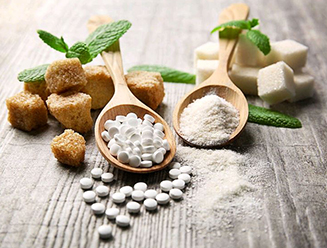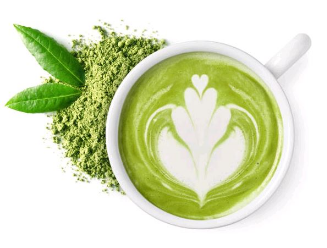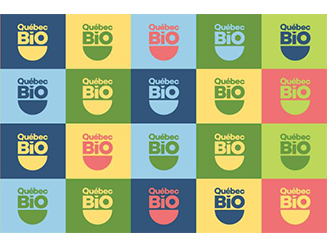Sucralose, aspartame, acesulfame-potassium, neotame, alitame, cyclamate and saccharin are synthetic sweeteners. “To sweeten” means to sweeten, to add a sugar or other food having a sweetening power. They are said to be “synthetic” because they come from the laboratory transformation of different chemical compounds. Hence their other name “artificial sweeteners”. They are also referred to as “intense sweeteners” because of their very high sweetness.
Two categories
Synthetic sweeteners fall into two categories: first generation sweeteners (saccharin, cyclamate, aspartame) and second generation sweeteners (sucralose, acesulfame-potassium, neotame, alitame).
Where do they come from?
Synthetic sweeteners are chemical compounds from different origins or from various substances. Two examples: aspartame and sucralose.
Aspartame is made up of two amino acids: aspartic acid and phenylalanine. The substance, once transformed by the body, produces a small amount of methanol, hence the controversy surrounding its use.
Only sucralose comes originally from sugar. The process, patented of course, consists of introducing three chlorine atoms in place of three groups of hydrogen and oxygen atoms present on the molecule of sucrose (sugar). The molecule, thus modified, is therefore no longer a sugar, but a substance created from scratch by the hand of man.
How do they work?
Synthetic sweeteners are all based on the same principle: they are “empty” molecules, “non-foods”. The body does not recognize them as nutrients and therefore does not derive energy from them. Aside from aspartame, the artificial sweeteners marketed in the country (sucralose, cyclamate, saccharin, acesulfame-potassium) contain no calories. Aspartame contains 4 calories per gram.
| Substitutes | Uses | Sweetness** | ADI***mg/kg |
| Acesulfame-potassium (Sunett) |
Approved as a food additive for a host of processed foods Not sold as a table-top sweetener* |
200X | 15 |
| Aspartame (NutraSweet, Equal/Equal, Canderel) |
Approved as a food additive for a host of processed foods |
180X | 40 |
| Cyclamate (Sucaryl, Sweet’n Low, Sugar Twin) |
Approved as a table-top sweetener only* | 30 to 50X | 11 |
| Saccharin (Hermesetas) |
Approved as a table-top sweetener only* | 300 to 500X | 5 |
| Sucralose (Splenda) |
Approved as a food additive for a host of processed foods |
600X | 9 |
*The statement “Approved as a table-top sweetener only” means that this sweetener cannot be used as a food additive in Canada. No processed products (yogurt, jam, chocolate, etc.) should contain cyclamate or saccharin. The sale of these sweeteners remains permitted (for saccharin, only in pharmacies).
**Sweetness is based on that of sucrose (regular sugar).
***ADI: “Acceptable Daily Intake”. Public health authorities, including Health Canada, have set “acceptable daily intakes”, thresholds below which these food additives are deemed safe. (See the text Are they safe?). The ADIs mentioned in this table come from the research synthesis carried out by the Canadian Diabetes Association (see reference below) and have been validated with Health Canada. Generally speaking, they match the standards set by other public health authorities and may even be “safer”. For example, Health Canada has set the ADI for sucralose at 9 mg/kg, while a joint committee1 of the World Health Organization (WHO) and the Food and Agriculture Organization of the United Nations( FAO) “allows” up to 15 mg/kg.
How to calculate the correct dose?
Simply multiply its weight (in kilos) by the acceptable daily intake (ADI) corresponding to the sweetener present in the product. This result is then divided by the quantity (mg) of sweetener contained in the portion consumed (usually indicated on the packaging). Two examples:
60 kg (130 lb) person: 18 cans of diet soda per day!
Calculation: Weight (60 kg) x ADI aspartame (40 mg) = 2400. The ADI of aspartame for this person is therefore 2400 mg. The ADI (2400 mg) is divided by the amount in the serving consumed (131 mg of aspartame in a 355 ml can) = 18.
90-kilo (198-lb) person: 33 “calorie-reduced” yogurts per day!
Calculation: Weight (90 kg) x ADI sucralose (9 mg) = 810. The ADI of sucralose for this person is therefore 810 mg. The ADI (810 mg) is divided by the amount contained in the portion consumed (24 mg of sucralose in a small jar of 150 g) = 33
Of course, no one is recommended to consume so many diet sodas or reduced-calorie yogurts! These examples serve simply to illustrate, concretely, what the ADI are.
In short, according to established standards, you have to consume astronomical quantities of such products to expose your health to risks. Furthermore, it is important to note that the concentrations of sweeteners presented here come from a typical product: they are not necessarily representative of all products on the market.
Contraindications
Pregnant women should avoid taking saccharin and cyclamate. In fact, these products should only be consumed on the advice of a doctor.
As for aspartame, Health Canada2 considers it safe during pregnancy. “The consumption of aspartame in pregnant women is safe and does not pose any health risk. However, since the consumption of products containing aspartame and other intense sweeteners could substitute for the consumption of nutritious foods contributing to energy intake, pregnant women should be cautioned against excessive consumption of such products. “, he specifies. However, Health Canada has issued a warning for people with phenylketonuria. The latter should not consume aspartame, because it contains phenylalanine, a substance that these people cannot metabolize2.
What about other sweeteners?
SUGARS-ALCOHOLS
A distinction must be made between synthetic sweeteners and sugar alcohols, also called polyalcohols or polyols: maltitol, sorbitol, mannitol, xylitol, isomalt, etc. Although sugar alcohols are also synthesized in the laboratory, they are, to some extent, more “natural”. Indeed, they come from different sugars of vegetable origin. On the shelves, they are most often found in food products intended for diabetics, but also in candies, candies, gum, ice cream and some chocolates. They are not sold as table-top sweeteners.
Sugar alcohols have little impact on blood sugar, but consumed in large quantities, they can cause gastrointestinal disorders (flatulence, diarrhea, etc.).
STEVIA
We have been hearing a lot about stevia in recent years, a “new” sweetener from a small shrub native to South America (stevia rebaudiana). Stevia is a plant that has been used for a very long time in South America to sweeten drinks and food. The sale of stevia as a supplement is permitted in Canada, but it cannot be marketed there as a table-top sweetener or as a food additive. Currently, in Canada, stevia can be obtained in the form of dried leaf powder or standardized extract. The sweetness of stevia is 100 to 300 times that of sugar. Just one teaspoon of a standardized extract (90% stevioside) equals about three cups of sugar!
It is generally recommended that people with type 2 diabetes check their blood glucose levels more often following the introduction of stevia into their diet.
AGAVE SYRUP
This natural sweetener is also talked about because it has a higher sweetening power than white sugar, ie 1.4. In addition, as it contains a high proportion of fructose (from 60% to 90%), its glycemic index is low (around 20), which is an advantage for diabetics. This syrup is extracted from the sap present in the heart of the agave plant, which is also used to make tequila (Agava tequilana). Its taste is more neutral than that of honey. Its color varies from golden to dark brown, depending on the degree of purification. It can be found in health food stores. Be careful though, it is almost as caloric as sugar, around 17 calories per teaspoon against 20 for sugar. On the other hand, as its sweetening power is higher, less is used: it is generally suggested to replace 1 cup of sugar with 2/3 cup of agave syrup. Another disadvantage of this syrup: because of its high fructose content, it increases the level of triglycerides in the blood when consumed in large quantities. This increase is a factor in cardiovascular disease and insulin resistance.
Article taken from passport-sante.net/fr and loosely translated using Google Translate
For more information, visit https://www.canada.ca/en/health-canada/services/food-nutrition/food-safety/food-additives/permitted-lists/9-sweeteners.html





